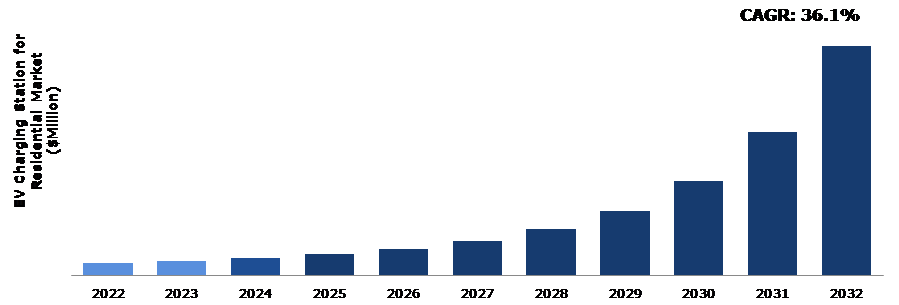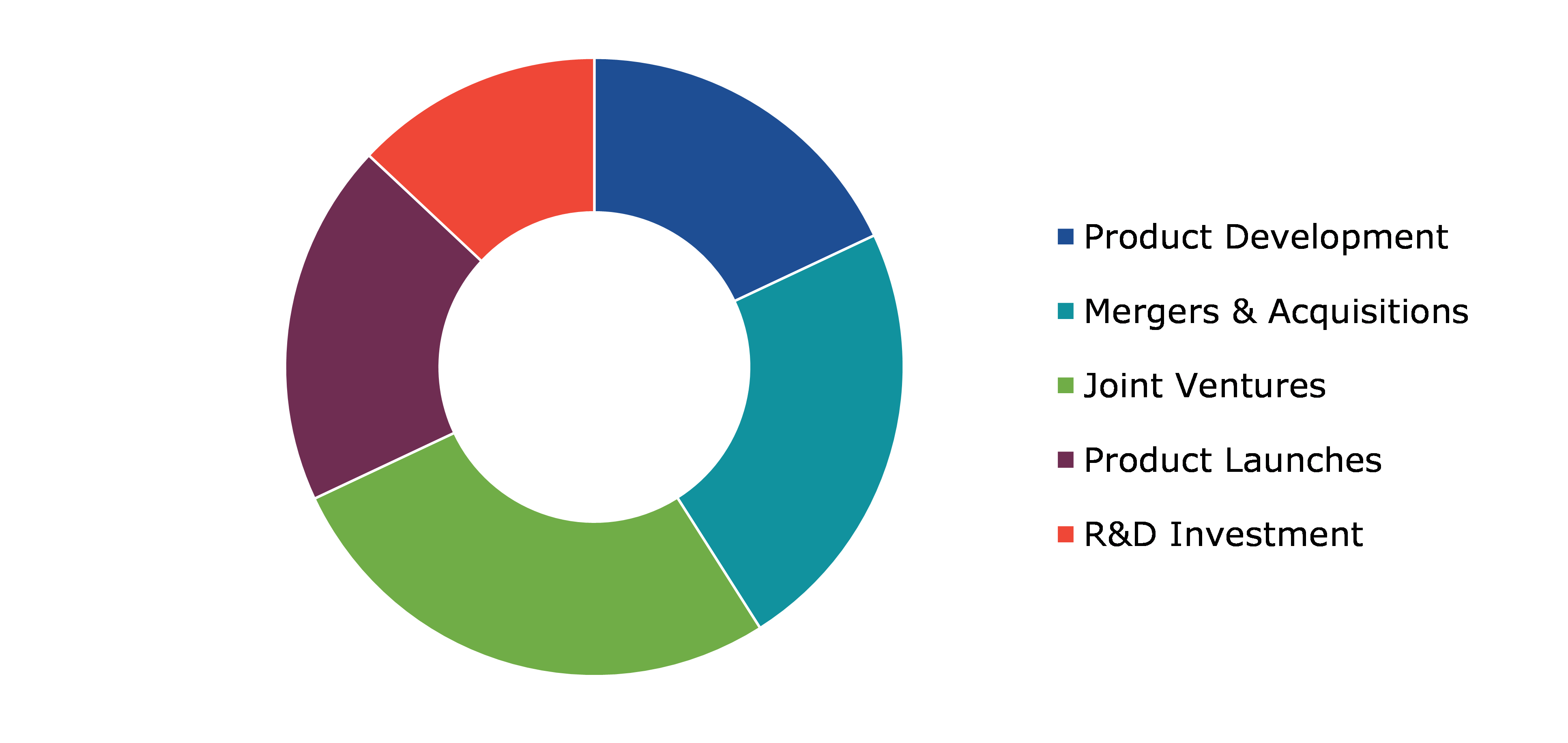EV Charging Station For Residential Market Report
RA09232
EV Charging Station for Residential Market by Charging Station Type (Less than 11 kW, 11 kW - 50 kW, and Above 50 kW), Vehicle Type (Passenger Cars and Commercial Vehicles), and Region (North America, Europe, Asia-Pacific, and LAMEA): Global Opportunity Analysis and Industry Forecast, 2023-2032
EV Charging Station for Residential Overview
One of the defining characteristics of home EV charging stations is their compatibility with multiple electric automobile models, which ensures versatility and adaptation in the continually developing EV industry. These charging stations are available in a variety of power levels, often referred to as Level 1 and Level 2 chargers, to meet the demands of a wide range of consumers. Level 1 chargers use a typical household electrical socket to charge at a slower rate, making them suited for overnight charging. Level 2 chargers, on the other hand, demand a higher voltage power supply, providing a faster charging alternative and suiting the hectic lifestyles of many EV owners. The primary goal of a home EV charging station is to give EV owners with a dedicated and efficient way to recharge their vehicle's battery at home. These charging stations are often installed in garages or driveways and provide a personalized and dependable solution for everyday charging requirements.
Global EV Charging Station for Residential Market Analysis
The global EV charging station for residential market size was $5,376.00 million in 2022 and is predicted to grow with a CAGR of 36.1%, by generating a revenue of $101,035.80 million by 2032.
Source: Research Dive Analysis
COVID-19 Impact on the Global EV Charging Station for Residential Market
The changing consumer behavior was one of the notable impacts of the COVID-19 pandemic on household EV charging stations. People who used to rely on public transit began to consider electric vehicles as a more sustainable and safe option, resulting in an increase in EV sales. Therefore, the need for simple and effective domestic charging options grew. As more people became interested in electric vehicles, the demand for creative and user-friendly charging options grew.
Companies invested in R&D to build smart charging stations with features such as remote monitoring, scheduling, and payment choices. This emphasis on technology advancements not only answered customers' changing expectations, but also positioned the domestic EV charging sector as a key player in the larger smart home ecosystem. The incorporation of EV charging stations into residential areas gained significance as cities sought to develop more sustainable and resilient ecosystems.
Seamless and Accessible Charging for Electric Vehicles in the Residential Sector to Drive the Market Growth
The improved convenience for EV users is a core benefit of incorporating smooth and accessible EV charging in residential locations. Range anxiety, or the fear of running out of battery power in the face of inadequate charging infrastructure, has traditionally been a key hurdle to mainstream EV adoption. EV owners can charge their vehicles overnight or during downtime if residential areas have publicly accessible charging stations, minimizing the need for frequent visits to public charging stations. Individuals benefit from this convenience, making EV ownership more feasible and appealing. Accessibility is critical to guaranteeing the inclusiveness of EV adoption. The installation of charging infrastructure in residential areas appeals to a wide variety of demographic groupings, making electric mobility more accessible to a larger audience. This inclusion is especially important in metropolitan settings, where a large segment of the population may lack access to private charging infrastructure. Apartment residents, persons without dedicated parking spots, or those living in places where creating private charging infrastructure is problematic might get assistance from publicly accessible home charging stations. The use of smart technology expands the benefits of domestic EV charging. Remote monitoring, control, and optimization of charging processes are possible with smart charging solutions.
Initial Installation Cost to Restrain the Market Growth
One of the biggest limitations is the financial load on homeowners. The installation of an EV charging station at home sometimes needs changes to the electrical system to meet the increased power consumption. Homeowners may need to invest in a larger-capacity electrical panel, wiring, and potentially even a specialized transformer, all of which add to the overall cost. Despite the long-term cost reductions associated with electric mobility, many people, particularly those with little financial means, are put off by the heavy initial costs. Furthermore, the necessity for specialized electrical work during installation raises the entire cost substantially. Upgrading the current electrical panel to meet higher voltage requirements, establishing dedicated circuits, and ensuring compliance with local electrical standards are all critical procedures that can drive up installation costs. The technical nature of these electrical adjustments may cause homeowners to struggle, adding to the financial burden involved with the move to electric automobiles. In addition to financial constraints, logistical issues emerge as impediments to the installation of domestic EV charging stations. Allocating room for a charging station can be an issue for many homeowners, especially in metropolitan areas with limited parking. The demand for a dedicated parking place near the electrical panel adds another degree of complication, and residents may have difficulty integrating charging infrastructure into their living areas if authorized parking is unavailable. This constraint is a significant impediment, particularly in highly populated places where parking is already limited.
Wireless Charging of EV Vehicles to Drive Excellent Opportunities
Rising demand for user-friendly solutions is one of the primary factors supporting the advancement of wireless charging for EVs in residential settings. Traditional plug-in charging systems have drawbacks, frequently requiring drivers to locate the correct cable, line it properly, and make a secure connection. Wireless charging eliminates these inconveniences, providing a smooth and simple experience. EV owners may just park their vehicles over a specified charging pad, initiating the charging process without any physical connection, due to the utilization of sophisticated electromagnetic fields. This simplicity not only improves the user experience but also encourages more people to buy electric automobiles. Wireless charging presents potential that extend beyond consumer convenience. The technology enables smart and integrated solutions, transforming residential areas into sustainable energy centers. Wireless charging may be readily integrated into smart home ecosystems as houses become more networked via the Internet of Things (IoT). Homeowners, for example, may plan charging periods during off-peak hours to take advantage of reduced electricity costs while minimizing overall impact on the power infrastructure. Furthermore, the use of renewable energy sources, such as solar panels, can improve the durability of EV charging in residential areas, therefore contributing to a cleaner and greener future. Furthermore, wireless charging technology promotes an atmosphere suitable to invention and cooperation. Companies in the technology and energy industries are investing considerably in R&D to improve the efficiency and efficacy of wireless charging devices. Therefore, more compact and powerful charging pads have emerged, capable of enabling quicker charging rates without compromising safety.
Global EV Charging Station for Residential Market Share, by Charging Station Type, 2022
Source: Research Dive Analysis
The less than 11 kW sub-segment accounted for the highest market share in 2022. The ease of installing less than 11 kW EV charging stations at home is one of the key motivators. Residential charging allows EV owners to charge their vehicles overnight or during times of low power demand. A home charging station avoids the need for frequent journeys to public charging stations, making EV ownership more practical for everyday travel. Operating a charging station with a capacity of less than 11 kW at home is often less expensive than depending on public charging infrastructure. Residential power tariffs are frequently lower, especially during off-peak hours, resulting in considerable long-term cost savings. EV owners may optimize their charging schedules to save expenses and improve the overall economics of electric car ownership by taking advantage of decreased energy prices. Installing a home charging station lowers reliance on public charging infrastructure, which is not always accessible or convenient to use. This self-sufficiency ensures that EV users have access to a dependable and dedicated charging option. When compared to higher-capacity charging devices, less than 11 kW charging stations are often easier and less expensive to install in residential situations. Because of the lower power requirements, major electrical improvements may not be required, making installation easier and more accessible.
Global EV Charging Station for Residential Market Share, by Vehicle Type, 2022
Source: Research Dive Analysis
The passenger cars sub-segment accounted for the highest market share in 2022. The increasing popularity of electric vehicles is a major factor in the expansion of household EV charging stations. As more people choose EVs, the need for home charging infrastructure grows. People are choosing electric vehicles because they are more aware of environmental concerns and want to lower their environmental impact. Residential charging stations allow EV owners to charge their vehicles at home, encouraging more people to make the environmentally favorable move. Battery technology developments lead to better driving ranges and faster charging capabilities for electric cars. The need for household charging stations is increasing as EVs become more efficient and convenient. Charging an electric car at home is frequently less expensive than charging it at a public charging station. Homeowners can benefit from cheaper power bills during off-peak hours, resulting in considerable long-term savings. Residential EV charging stations may now be incorporated into home energy management systems thanks to improvements in smart home technologies. This enables consumers to optimize charging periods depending on energy availability and cost, maximizing cost savings even further.
Global EV Charging Station for Residential Market Size & Forecast, by Region, 2022 2032 ($Million)
Source: Research Dive Analysis
The Europe EV charging station for residential market generated the highest revenue in 2022. Europe has been at the forefront of global climate change initiatives. Governments and individuals are becoming increasingly conscious regarding traditional gasoline-powered automobiles' environmental effect. The move to EVs is a critical approach for reducing carbon emissions and mitigating the consequences of climate change. Several European countries have put laws and incentives in place to encourage the use of electric vehicles. These measures include tax incentives, subsidies, and grants for both EV purchases and household charging station installation. Governments recognize the need of constructing a solid charging infrastructure to aid in the transition to electric transportation. Europe has established aggressive pollution reduction objectives, and automakers are under pressure to meet stringent emission requirements. Increased expenditures in electric vehicle technology have emerged from the quest for greener transportation, making EVs more accessible and appealing to customers. Continuous breakthroughs in battery technology have increased the range and efficiency of electric cars. The need for household charging stations has increased as EVs become more viable for regular usage. Customers are more confident about the dependability and convenience of electric automobiles.
Competitive Scenario in the Global EV Charging Station for Residential Market
Product innovation & development and user experience are common strategies followed by major market players. For instance, April 14, 2023, Schneider Electric, a global leader in the digital transformation of energy management and automation, announced the launch of the EVlink Home charger. The charger incorporates new features aimed at making at-home charging easier to install and more cost-effective to use.
Source: Research Dive Analysis
Some of the leading EV charging station for residential market players are Tata Power, Siemens, ABB, Schneider Electric, Compleo Charging Solutions GmbH & Co. KG, Wallbox, Tesla, ChargePoint, Inc., Eaton Corporation plc, and Leviton..
| Aspect | Particulars |
| Historical Market Estimations | 2020-2021 |
| Base Year for Market Estimation | 2022 |
| Forecast Timeline for Market Projection | 2023-2032 |
| Geographical Scope | North America, Europe, Asia-Pacific, and LAMEA |
| Segmentation by Charging Station Type |
|
| Segmentation by Vehicle Type |
|
| Key Companies Profiled |
|
Q1. What is the size of the global EV charging station for residential market?
A. The size of the global EV charging station for residential market was $5,376.00 million in 2022 and is projected to reach $101,035.80 million by 2032.
Q2. Which are the major companies in the EV charging station for residential market?
A. Tata Power, Siemens, ABB, Schneider Electric, Compleo Charging Solutions GmbH & Co. KG, Wallbox, Tesla, ChargePoint, Inc., Eaton Corporation plc, and Leviton are some of the key players in the global EV charging station for residential market.
Q3. Which region, among others, possesses greater investment opportunities in the future?
A. Asia-Pacific possesses great investment opportunities for investors in the future.
Q4. What will be the growth rate of the Asia-Pacific EV charging station for residential market?
A. The Asia-Pacific EV charging station for residential market is anticipated to grow at 37.5% CAGR during the forecast period.
Q5. What are the strategies opted by the leading players in this market?
A. Product innovation and development of EV charging stations are the two key strategies opted by the operating companies in this market.
Q6. Which companies are investing more on R&D practices?
A. Tesla and Siemens are the companies investing more on R&D activities for developing new products and technologies.
1. Research Methodology
1.1. Desk Research
1.2. Real time insights and validation
1.3. Forecast model
1.4. Assumptions and forecast parameters
1.5. Market size estimation
1.5.1. Top-down approach
1.5.2. Bottom-up approach
2. Report Scope
2.1. Market definition
2.2. Key objectives of the study
2.3. Report overview
2.4. Market segmentation
2.5. Overview of the impact of COVID-19 on global EV charging station for residential market
3. Executive Summary
4. Market Overview
4.1. Introduction
4.2. Growth impact forces
4.2.1. Drivers
4.2.2. Restraints
4.2.3. Opportunities
4.3. Market value chain analysis
4.3.1. List of raw material suppliers
4.3.2. List of manufacturers
4.3.3. List of distributors
4.4. Innovation & sustainability matrices
4.4.1. Technology matrix
4.4.2. Regulatory matrix
4.5. Porter’s five forces analysis
4.5.1. Bargaining power of suppliers
4.5.2. Bargaining power of consumers
4.5.3. Threat of substitutes
4.5.4. Threat of new entrants
4.5.5. Competitive Rivalry Intensity
4.6. PESTLE analysis
4.6.1. Political
4.6.2. Economical
4.6.3. Social
4.6.4. Technological
4.6.5. Legal
4.6.6. Environmental
4.7. Impact of COVID-19 on EV charging station for residential market
4.7.1. Pre-covid market scenario
4.7.2. Post-covid market scenario
5. EV Charging Station for Residential Market Analysis, By Charging Station Type
5.1. Overview
5.2. Less than 11 kW
5.2.1. Definition, key trends, growth factors, and opportunities
5.2.2. Market size analysis, by region, 2022-2032
5.2.3. Market share analysis, by country, 2022-2032
5.3. 11 kW - 50 kW
5.3.1. Definition, key trends, growth factors, and opportunities
5.3.2. Market size analysis, by region, 2022-2032
5.3.3. Market share analysis, by country, 2022-2032
5.4. Above 50 kW
5.4.1. Definition, key trends, growth factors, and opportunities
5.4.2. Market size analysis, by region, 2022-2032
5.4.3. Market share analysis, by country, 2022-2032
5.5. Research Dive Exclusive Insights
5.5.1. Market attractiveness
5.5.2. Competition heatmap
6. EV Charging Station for Residential Market Analysis, by Vehicle Type
6.1. Overview
6.2. Passenger Cars
6.2.1. Definition, key trends, growth factors, and opportunities
6.2.2. Market size analysis, by region, 2022-2032
6.2.3. Market share analysis, by country, 2022-2032
6.3. Commercial Vehicles
6.3.1. Definition, key trends, growth factors, and opportunities
6.3.2. Market size analysis, by region, 2022-2032
6.3.3. Market share analysis, by country, 2022-2032
6.4. Research Dive Exclusive Insights
6.4.1. Market attractiveness
6.4.2. Competition heatmap
7. EV Charging Station for Residential Market, by Region
7.1. North America
7.1.1. U.S.
7.1.1.1. Market size analysis, by Charging Station Type, 2022-2032
7.1.1.2. Market size analysis, by Vehicle Type, 2022-2032
7.1.2. Canada
7.1.2.1. Market size analysis, by Charging Station Type, 2022-2032
7.1.2.2. Market size analysis, by Vehicle Type, 2022-2032
7.1.3. Mexico
7.1.3.1. Market size analysis, by Charging Station Type, 2022-2032
7.1.3.2. Market size analysis, by Vehicle Type, 2022-2032
7.1.4. Research Dive Exclusive Insights
7.1.4.1. Market attractiveness
7.1.4.2. Competition heatmap
7.2. Europe
7.2.1. Germany
7.2.1.1. Market size analysis, by Charging Station Type, 2022-2032
7.2.1.2. Market size analysis, by Vehicle Type, 2022-2032
7.2.2. UK
7.2.2.1. Market size analysis, by Charging Station Type, 2022-2032
7.2.2.2. Market size analysis, by Vehicle Type, 2022-2032
7.2.3. France
7.2.3.1. Market size analysis, by Charging Station Type, 2022-2032
7.2.3.2. Market size analysis, by Vehicle Type, 2022-2032
7.2.4. Spain
7.2.4.1. Market size analysis, by Charging Station Type, 2022-2032
7.2.4.2. Market size analysis, by Vehicle Type, 2022-2032
7.2.5. Italy
7.2.5.1. Market size analysis, by Charging Station Type, 2022-2032
7.2.5.2. Market size analysis, by Vehicle Type, 2022-2032
7.2.6. Rest of Europe
7.2.6.1. Market size analysis, by Charging Station Type, 2022-2032
7.2.6.2. Market size analysis, by Vehicle Type, 2022-2032
7.2.7. Research Dive Exclusive Insights
7.2.7.1. Market attractiveness
7.2.7.2. Competition heatmap
7.3. Asia-Pacific
7.3.1. China
7.3.1.1. Market size analysis, by Charging Station Type, 2022-2032
7.3.1.2. Market size analysis, by Vehicle Type, 2022-2032
7.3.2. Japan
7.3.2.1. Market size analysis, by Charging Station Type, 2022-2032
7.3.2.2. Market size analysis, by Vehicle Type, 2022-2032
7.3.3. India
7.3.3.1. Market size analysis, by Charging Station Type, 2022-2032
7.3.3.2. Market size analysis, by Vehicle Type, 2022-2032
7.3.4. South Korea
7.3.4.1. Market size analysis, by Charging Station Type, 2022-2032
7.3.4.2. Market size analysis, by Vehicle Type, 2022-2032
7.3.5. Australia
7.3.5.1. Market size analysis, by Charging Station Type, 2022-2032
7.3.5.2. Market size analysis, by Vehicle Type, 2022-2032
7.3.6. Rest of Asia-Pacific
7.3.6.1. Market size analysis, by Charging Station Type, 2022-2032
7.3.6.2. Market size analysis, by Vehicle Type, 2022-2032
7.3.7. Research Dive Exclusive Insights
7.3.7.1. Market attractiveness
7.3.7.2. Competition heatmap
7.4. LAMEA
7.4.1. Brazil
7.4.1.1. Market size analysis, by Charging Station Type, 2022-2032
7.4.1.2. Market size analysis, by Vehicle Type, 2022-2032
7.4.2. UAE
7.4.2.1. Market size analysis, by Charging Station Type, 2022-2032
7.4.2.2. Market size analysis, by Vehicle Type, 2022-2032
7.4.3. South Arabia
7.4.3.1. Market size analysis, by Charging Station Type, 2022-2032
7.4.3.2. Market size analysis, by Vehicle Type, 2022-2032
7.4.4. South Africa
7.4.4.1. Market size analysis, by Charging Station Type, 2022-2032
7.4.4.2. Market size analysis, by Vehicle Type, 2022-2032
7.4.5. Rest of LAMEA
7.4.5.1. Market size analysis, by Charging Station Type, 2022-2032
7.4.5.2. Market size analysis, by Vehicle Type, 2022-2032
7.4.6. Research Dive Exclusive Insights
7.4.6.1. Market attractiveness
7.4.6.2. Competition heatmap
8. Competitive Landscape
8.1. Top winning strategies, 2022
8.1.1. By strategy
8.1.2. By year
8.2. Strategic overview
8.3. Market share analysis, 2022
9. Company Profiles
9.1. Siemens
9.1.1. Overview
9.1.2. Business segments
9.1.3. Product portfolio
9.1.4. Financial performance
9.1.5. Recent developments
9.1.6. SWOT analysis
9.2. Tata Power
9.2.1. Overview
9.2.2. Business segments
9.2.3. Product portfolio
9.2.4. Financial performance
9.2.5. Recent developments
9.2.6. SWOT analysis
9.3. ABB
9.3.1. Overview
9.3.2. Business segments
9.3.3. Product portfolio
9.3.4. Financial performance
9.3.5. Recent developments
9.3.6. SWOT analysis
9.4. Schneider Electric
9.4.1. Overview
9.4.2. Business segments
9.4.3. Product portfolio
9.4.4. Financial performance
9.4.5. Recent developments
9.4.6. SWOT analysis
9.5. Compleo Charging Solutions GmbH & Co. KG
9.5.1. Overview
9.5.2. Business segments
9.5.3. Product portfolio
9.5.4. Financial performance
9.5.5. Recent developments
9.5.6. SWOT analysis
9.6. Wallbox
9.6.1. Overview
9.6.2. Business segments
9.6.3. Product portfolio
9.6.4. Financial performance
9.6.5. Recent developments
9.6.6. SWOT analysis
9.7. ChargePoint, Inc.
9.7.1. Overview
9.7.2. Business segments
9.7.3. Product portfolio
9.7.4. Financial performance
9.7.5. Recent developments
9.7.6. SWOT analysis
9.8. Tesla
9.8.1. Overview
9.8.2. Business segments
9.8.3. Product portfolio
9.8.4. Financial performance
9.8.5. Recent developments
9.8.6. SWOT analysis
9.9. Leviton
9.9.1. Overview
9.9.2. Business segments
9.9.3. Product portfolio
9.9.4. Financial performance
9.9.5. Recent developments
9.9.6. SWOT analysis
9.10. Eaton Corporation PLC
9.10.1. Overview
9.10.2. Business segments
9.10.3. Product portfolio
9.10.4. Financial performance
9.10.5. Recent developments
9.10.6. SWOT analysis
Personalize this research
- Triangulate with your own data
- Request your format and definition
- Get a deeper dive on a specific application, geography, customer or competitor
- + 1-888-961-4454 Toll - Free
- support@researchdive.com






